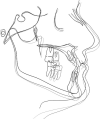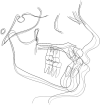Long-term stability of rapid maxillary expansion combined with chincup protraction followed by fixed appliances
- PMID: 24892796
- PMCID: PMC8631887
- DOI: 10.2319/012514-68.1
Long-term stability of rapid maxillary expansion combined with chincup protraction followed by fixed appliances
Abstract
Objective: To analyze the long-term stability of rapid maxillary expansion (RME) and protraction from chincup therapy in girls with Class III malocclusion.
Materials and methods: Twenty-two girls (mean age = 9.1 ± 0.6 years) with Class III malocclusion were treated with combined RME and protraction from a chincup, followed by fixed appliances. Lateral cephalograms were evaluated before treatment, at the end of a two-phase treatment protocol (mean age = 15.1 ± 1.1 years), and 10.9 ± 0.5 years after the end of treatment (mean age = 27.5 ± 0.5 years). The control group consisted of 22 matched girls with skeletal Class I malocclusion.
Results: After treatment, the Class III group showed significant improvement of the Class III malocclusion, mainly due to changes in the mandible (ie, SNB angle decreased 1.8 ± 1.6°) and significant improvement of the sagittal maxillomandibular relationship (Wits appraisal increased 2.6 ± 2.1 mm; ANB angle increased 1.0 ± 0.3 mm). These changes remained stable for an average of 10 years after the end of therapy. No tendency toward relapse was detected, and the mandibular position showed favorable outcomes.
Conclusions: RME and protraction from chincup therapy led to successful long-term outcomes in 18 of 22 patients (81.8%). This treatment approach can be considered an efficient therapy in growing girls with mild skeletal Class III malocclusion caused by maxillary retrusion and mandibular protrusion.
Keywords: Chincup; Class III; Long-term; Maxillary protraction; Stability.
Figures


Similar articles
-
Stability of rapid maxillary expansion and facemask therapy: a long-term controlled study.Am J Orthod Dentofacial Orthop. 2011 Oct;140(4):493-500. doi: 10.1016/j.ajodo.2010.09.031. Am J Orthod Dentofacial Orthop. 2011. PMID: 21967936 Clinical Trial.
-
The effects of maxillary protraction and its long-term stability--a clinical trial in Chinese adolescents.Eur J Orthod. 2012 Feb;34(1):88-95. doi: 10.1093/ejo/cjq185. Epub 2011 Feb 16. Eur J Orthod. 2012. PMID: 21325335
-
Long-term results of surgically assisted maxillary protraction vs regular facemask.Angle Orthod. 2014 Nov;84(6):1002-9. doi: 10.2319/120913-905.1. Epub 2014 Mar 21. Angle Orthod. 2014. PMID: 24654941 Free PMC article.
-
Clinical effects of maxillary protraction in different stages of dentition in skeletal class III children: A systematic review and meta-analysis.Orthod Craniofac Res. 2022 Nov;25(4):549-561. doi: 10.1111/ocr.12569. Epub 2022 Mar 23. Orthod Craniofac Res. 2022. PMID: 35303382
-
Efficacy of short-term chincup therapy for mandibular growth retardation in Class III malocclusion.Angle Orthod. 2011 Jan;81(1):162-68. doi: 10.2319/050510-244.1. Angle Orthod. 2011. PMID: 20936970 Free PMC article. Review.
Cited by
-
ER-induced PERK/TFEB cascade sequentially modulates mitochondrial dynamics during cranial suture expansion.Bone Res. 2025 Jun 23;13(1):66. doi: 10.1038/s41413-025-00427-y. Bone Res. 2025. PMID: 40550802 Free PMC article.
-
Comparison of facemask therapy effects using skeletal and tooth-borne anchorage.Angle Orthod. 2022 May 1;92(3):307-314. doi: 10.2319/032121-219.1. Angle Orthod. 2022. PMID: 34964848 Free PMC article.
-
Maxillofacial growth changes after maxillary protraction therapy in children with class III malocclusion: a dual control group retrospective study.BMC Oral Health. 2024 Jan 3;24(1):7. doi: 10.1186/s12903-023-03790-6. BMC Oral Health. 2024. PMID: 38172784 Free PMC article.
-
Sexual dimorphism in the long-term stability (10 years) of skeletal Class III treatment.Prog Orthod. 2021 Jun 21;22(1):13. doi: 10.1186/s40510-021-00360-w. Prog Orthod. 2021. PMID: 34151390 Free PMC article.
-
Treatment Options for Class III Malocclusion in Growing Patients with Emphasis on Maxillary Protraction.Scientifica (Cairo). 2016;2016:8105163. doi: 10.1155/2016/8105163. Epub 2016 Apr 10. Scientifica (Cairo). 2016. PMID: 27144056 Free PMC article. Review.
References
-
- Franchi L, Baccetti T, McNamara JA. Postpubertal assessment of treatment timing for maxillary expansion and protraction therapy followed by fixed appliances. Am J Orthod Dentofacial Orthop. 2004;126:555–568. - PubMed
-
- Vaughn GA, Mason B, Moon HB, Turley PK. The effects of maxillary protraction therapy with or without rapid palatal expansion: a prospective, randomized clinical trial. Am J Orthod Dentofacial Orthop. 2005;128:299–309. - PubMed
-
- Kama JD, Ozer T, Baran S. Orthodontic and orthopaedic changes associated with treatment in subjects with Class III malocclusions. Eur J Orthod. 2006;28:496–502. - PubMed
-
- Mandall N, DiBiase A, Littlewood S, et al. Is early Class III protraction facemask treatment effective? A multicentre, randomized, controlled trial: 15-month follow-up. J Orthod. 2010;37:149–161. - PubMed
-
- Yoshida I, Shoji T, Mizoguchi I. Effects of treatment with a combined maxillary protraction and chincap appliance in skeletal Class III patients with different vertical skeletal morphologies. Eur J Orthod. 2007;29:126–133. - PubMed
Publication types
MeSH terms
LinkOut - more resources
Full Text Sources

